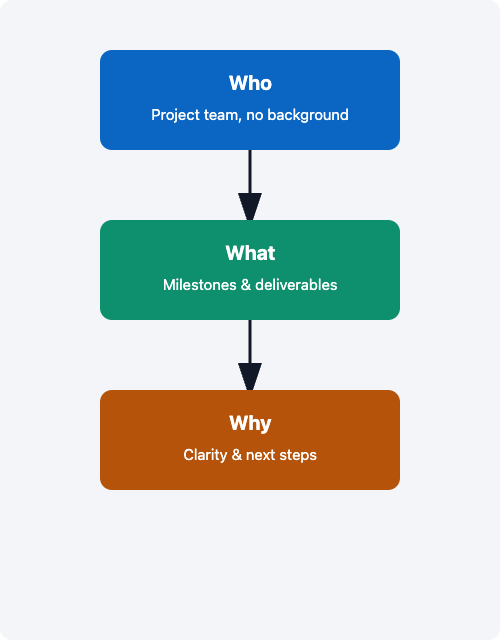One of the best ways to keep a project organized is through clear documentation. It ensures your team is always on the same page and can move forward with confidence. When you write, organize, and maintain project documents effectively, everyone can easily find what they need, understand what’s happening, and trust the process.
You’ll often find yourself:
- Set up a single, accessible location for all project files to prevent confusion and save time.
- Use clear, consistent naming and concise summaries so everyone can quickly find and understand key information.
- Keep a record of decisions and next steps to ensure transparency and accountability.
A messy document system leads to confusion and wasted time. Choose one platform (like Google Drive, Notion, SharePoint, or Confluence) and make sure everyone knows where to find the latest files. Use naming conventions that include dates and topics, such as "2024-09-09_ProjectKickoff_Notes.docx", instead of something generic like "notes.docx". This way, anyone can find the right file no matter how much time has passed.
Tip: If you’re working with external partners, set permissions and share links up front. This avoids bottlenecks and ensures everyone has access to what they need, when they need it.
Great documentation is written for the reader, not the writer. Before you start, think about who will use the document, what they need to know, and why this information is relevant. We can remember how to write effective documentation by using the Who, What, and Why framework:
- Who is the document for? Consider your audience and their level of familiarity with the topic.
- What do they need to know? Focus on the most important information, using short sentences and clear headers.
- Why does it matter? Highlight what’s actionable or relevant so readers understand the impact and next steps.

For example, if your audience (Who) is the project team, your document (What) should outline key milestones and deliverables. This approach provides (Why) clarity on progress and clear next steps, so everyone knows what to expect and how to move forward.
Applying this framework is especially important when documenting project decisions and changes. Keep a simple, up-to-date record of key decisions and changes. Each entry should capture what was decided, when, by whom, and why, plus any next steps or risks. For example:
"Decision: Move launch date to September 10. Date: August 15, 2025. By: Project team (approved by sponsor). Reason: Additional QA needed after feedback. Impacts: Marketing timeline, customer communications. Next steps: Update project plan, notify stakeholders."
This habit helps resolve confusion later and shows your commitment to clear, accountable leadership.
Here’s how a constructive conversation about documentation might sound:
- Jessica: Hey Chris, I noticed the last meeting notes were just titled "notes.docx". It took me a while to find the right file.
- Chris: Oh, sorry about that! I’ll start using the format "2024-09-09_ProjectKickoff_Notes.docx" from now on.
- Jessica: That would be great. Also, could you add a quick summary at the top? Something like "Timeline updated: Launch moved to September 10. New task: QA to complete testing by August 30."
